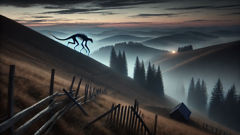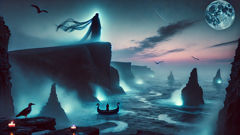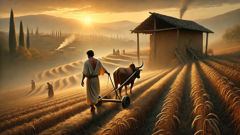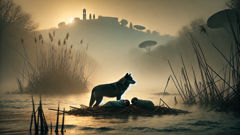Introduction
The Carpathians are a chain of voices that refuse to be hushed. Wind moves through their spruce and beech like a rumor—soft at first, then gathering, then baring its teeth on the ridgeline. In the small villages that dot their valleys, those voices are known by shape: the songs of shepherds and the creak of wooden gates, the distant toll of a church bell, the laugh of a woman stirring polenta, the lowing of a cow. Recently a new voice threaded through those sounds, an unsettled note that arrived with missing livestock and late-night phone videos. People began to speak of a creature that was not supposed to live in these mountains, a spiny silhouette stealing through moss and heather under a moon that seemed too small for the sky. They called it the Chupacabra, a name borrowed from a faraway Caribbean rumor, and by naming it they folded it into the landscape. But names change things. Here, in the wet cold of Ukrainian dawns, the Chupacabra took on a new accent. It walked between the folklore of the Hutsuls and the logic of veterinarians, between drone footage shared on social media and the old charms kept in cedar chests. The result was neither wholly myth nor clean science but a hybrid that felt appropriate to a time when the ancient world and modern tools touch constantly. Shepherds who had lived their whole lives with owls and wolves found themselves speaking cautiously of glowing eyes and tracks like the print of a leather boot with claws. Teenagers posted shaky videos with geotags and hashtags. A handful of biologists, curious and skeptical, packed their kits and drove the narrow mountain roads, arriving with sterile gloves and thermal cameras. Above all, the Carpathians listened. The mountains keep their own record: hoof prints erased by rainfall, footprints hidden by drift, the scent of something that unsettles animals before it is seen. In those records, the Chupacabra was less a single being than a constellation of moments—broken fence wire, drained udders, the sudden silence of a flock. This is how stories begin in places where weather and living things are the real powers: an accumulation of moments, each plausible enough on its own, together forming a pattern that refuses easy explanation. In the pages that follow, I gathered interviews with elders who still remember wartime shortages and with young people who know the exact buzz of a drone camera. I walked the paths used by goats and the old logging roads now forty years overgrown with birch. I listened to legends as they were told in low voices and examined evidence as clinical reports. Both kinds of testimony are threads. Put together, they weave a portrait of a creature that, whether true or imagined, matters because of what it reveals about the people who tell the tale and the landscape that sustains it.
Tracks in the Moss: Sightings, Stories, and the People Who Saw Them
The shepherd who first alerted the valley preferred to be called Mykola by the locals and nicknamed by journalists as a man who kept to his timetable: goats out at first light, back at dusk, a pot of tea on whenever pacing clouds made the light right. He is not who the camera crews usually seek. He is full-throated and blunt, an old man who can order a herd like a conductor and knows the weather by the way moss smells. His report came on a damp morning in late October, after a night of wind that shook the church bell from its rope and set combed hair streaming across the sleeping village. Mykola had found three of his goats in the brush, unnaturally drained and away from each other, each with a neat incision and little blood where it should have pooled. The first time the word chupacabra rose between men at the tavern, it was muttered, then barked with laughter. The second time, there was less laughter. There is a practical economy to mountain folk. They name risks so as to be able to count them. Naming something offers a kind of control. After that, more accounts followed, like drops in a stream that lead to an eddy: a younger shepherd, Irina, reported a rustling near her timber home and the sense of being watched; a family near the upper road found their barn door pawed open, hay scattered as if by small hands; a hunter reported seeing a low-slung shape crossing a logging road, fur matted with dew, eyes reflecting his torch like the eyes of a trapped animal. When I met the elders of the village, seated on benches in a low, smoke-darkened kitchen, they listened without scorn. The Hutsul elder, Maria, folded her hands and began not with the modern name but with the old ones; she spoke of zaliznyky, spirits of the mountains who bend the weather and sometimes lead livestock astray, and of snihi, restless children of the forest. These are not direct mappings to the chupacabra of Puerto Rican or Latin American lore, but they operate similarly: they offer moral explanations for losses and cautions for the living. A legend grows by fitting itself into an existing lattice of belief. That is why the Carpathian chupacabra must be heard as a local thing, flavored by the region's own histories and needs. Yet there is a new layer: smartphones. Teenagers with too much curiosity and too little patience recorded videos in which grainy silhouettes cross meadows, captured from a trembling drone or a handheld phone. Some videos are clearly misidentifications: foxes on stilts, stray dogs with thin coats, even the awkward motion of an exhausted sheep. But a number of clips remain stubborn; they show an animal with an angular head, a hunched back, and a spine disturbed by what looks like quills or matted hair. These clips circulated rapidly. In a week the story moved from the tavern to national forums, then to international threads where authors of cryptozoology websites decanted the footage into analysis and speculation. Scientists offered more measured responses. A local veterinarian, Olena, traveled from the town clinic with a flashlight and a firm manner. She examined wounds and took swabs. Her initial conclusion was practical: predators do attack livestock, but the nature of the cuts—clean, small, not tearing—was unusual for wolf or fox. She sent tissue samples to a laboratory in the regional center. Nothing supernatural was found in the lab notes: no unique pathogen, no signature of radiation, no definitive evidence that a new species had appeared. Instead, the tests underscored how much remains ambiguous in the life of these mountains. The tissue was degraded, the samples contaminated by field conditions, and the animals often discovered hours after the event. Yet those who had lived longer in the region emphasized pattern over proof. Patterns do not require the microscope. They require memory. For generations, shepherds learned to read the landscape like a living ledger: tracks softened by rain, scats distinguished by the subtleties of smell, the rhythm of a flock's movement. When that rhythm breaks, people listen for a cause. For some, the chupacabra was a rare predator, for others a symptom of environmental shift—a fox-like animal adapting to new food sources, an unfamiliar parasite, or a deepening human intrusion into wild places. For the old women who keep charms and stories, it was a reminder that the mountains keep old habits and that humans who forget their part in the ecology will pay. I walked the slopes with several of them, tracing the paths the goats had taken, poking at mud warmed by daylight to reveal impressions the rain would soon blur. The tracks were odd: a composite of prints and slides, as if an elongated paw had slipped and dragged. At the base of one tree, hair matted and stuck to the bark with resin gave off an acrid smell, something like the scent of fur singed and of sweet sap. Up close, it looked like the coat of a small to medium-sized animal, but the hair was coarser than the sheep nearby and threaded with a darker filament that might be mud. This is where modern tools met oral tradition. A drone camera hovered above one slope at dusk, its small lights blinking like wary moths. It recorded heat signatures moving across a rocky cleft, inconclusive but suggestive. To the villagers the drone was both alien and familiar: it was a toy for some, a watchful eye for others. The footage became part of the valley's narrative, interpreted in taverns and kitchens and kitchens' adjacent Internet cafés. The more the footage spread, the more the story adapted. Those who visited bearing scientific language framed the event as a case study: a series of predation events with atypical features requiring multi-disciplinary attention. Those who visited with spiritual notes argued for the mountain's self-protection, a spike in misfortune because some balance had been upset. Everyone agreed that the mountains had changed, and that the Chupacabra—named, recorded, and argued about—was how the valley measured that change.
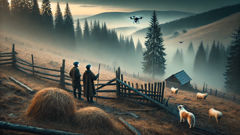
Between Science and Story: Investigation, Evidence, and How Myths Evolve
Investigation in a place like the Carpathians is never a purely laboratory affair. The first responders are often the community itself: neighbors who know each other's rhythms, who keep lists of how many animals should be in a pen, who can say in a whisper whether a wound falls into familiar patterns. When the regional laboratory returned results that were inconclusive rather than sensational, the story did not collapse. Instead it bifurcated: those satisfied by method among veterinarians and district biologists accepted uncertainty as an outcome; those drawn to pattern and narrative embraced the ambiguity and multiplied meanings. To study the phenomenon, I spoke with an ecologist who had spent decades cataloguing alpine species at the fringes of the timberline. She explained how human activity, climate variation, and shifting prey availability force animals to adopt new behaviors. A red fox that learns to take poultry at night, an escaped domestic dog establishing feral habits, or an invasive species widening its range could all produce the same signature of loss: clean incisions, drained carcasses, and a predator rarely seen. Then there were the things that data alone could not capture: silent farms in the morning where dew lay like glass, the way flocks huddled in different places than before, the lingering impression in animals that their nights had been unsettled. Field cameras placed along ridgelines recorded hours of emptiness and then a few minutes of motion: a sinewy shape slipping across a scree, a face caught by infrared that, when paused and replayed, suggested more than it showed. The best footage was never definitive; it relied on suggestion. That is partly the point. Our brains are pattern machines; given a blur, we fit what we know. For those who had grown up with stories of mountain spirits, the hint of quills or an angular snout was sufficient to trigger the old categories. For outsiders, the same hint was fodder for headlines. I traveled with two kinds of investigators: a young zoologist named Pavlo who measured hooves and took hair samples and a cultural anthropologist named Lena who recorded interviews with elders and catalogued charms. Pavlo was devoted to the slow accumulation of evidence—temperature logs, camera timetables, DNA swabs—while Lena was devoted to the architecture of talk: how accounts change when repeated, how metaphors migrate across communities, and how new technology becomes part of a tale. Together they demonstrated what a modern legend looks like: an object that moves across epistemologies, demanding both proof and meaning. Some of the most compelling material arrived when science and story were put side by side. For example, a nighttime observation by a family whose lambs had been taken yielded both a hair sample and a dream-like narrative. The father described a sound like brittle leaves and the feeling of being watched. The mother kept a small charm in the pocket of her apron, a blue bead strung on red thread said to ward off misfortune. They insisted that at the moment of loss they had felt the absence of grace—the same phrase an elder used when describing the time her grandfather lost a herd in the 1930s. Pavlo's hair analysis found a mixture of sequences typical of canids and domesticated goats, which suggested scavenging activity or contamination rather than a new predator. But Lena's recordings showed how the event had rearranged the family's memory, folding an older grief into the present anomaly. For the community, the Chupacabra served multiple functions. It answered why and how with mythic logic rather than lab reports. It repaired social bonds; when misfortune falls, neighbors come together, lights burn late, and stories are shared. It amplified caution; renewed attention to barns and pens reduced some losses, at least temporarily. It also revealed the permeability of modern information flows. The word chupacabra did not arise in a vacuum. It has a Puerto Rican origin and a set of images and expectations associated with Latin American reports of livestock drained of blood. That image traveled via the web, arriving as an interpretive template that locals could then adapt. In adapting it, they made the creature fit regional ecology and memory. The resulting figure is syncretic: part imported name, part local spirit, part animal behavior, and part the projection of anxieties about change. In the months after the first reports, other phenomena entered the valley's ecology. Drone watchers found unexplained nestings of invasive starlings near newly warmed streams, and a surge in stray dogs appeared near the lower roads. Climate shifts lengthened the grazing season by weeks, changing predators' and prey's cycles. Such conditions produce rare events that become stories. An interesting piece of cultural work occurred when a group of local schoolteachers encouraged students to collect accounts and test hypotheses. They taught basic recording skills: how to document time, place, and behavior; how to preserve hair samples; how to keep a neutrally worded diary. The children learned to be methodical and soon began to produce careful notes that surprised adults with their practicality. In time, some of those notes found their way to a regional university, where undergraduate students constructed maps of predation events across the county. Maps did not kill the legend. Instead they revealed clusters: some valleys experienced recurring events while others remained quiet. Clusters encourage narrative because they suggest pattern. At a larger level, the Chupacabra of the Carpathians forced an uneasy dialogue about conservation, rural decline, and cultural identity. Villages that had once relied on smallholdings now export labor to towns and abroad. Seasonal pastures are left less tended; wolves that were once persecuted have been legally protected and are reclaiming ranges. A modern predator, or a changing pattern of predation, is thus wrapped in an older narrative about who stays and who leaves, what gets protected, and what gets left to the mountains. In taverns, some men used the chupacabra tale to rail against urban ignorance; in classrooms, teachers used it to teach observation and critical thinking. The story proved malleable, useful in more ways than one. In the end, what remains are moments collected and named: the track in moss, the hair stuck to resin, the clip that refuses to settle into certainty, the charm never taken off a neckline. The Chupacabra is less a single beast than a place where ecological, technological, and cultural forces meet. It is a modern legend because it relies on both ancient voices and modern tools, and because it uses ambiguity as a kind of social glue, binding people together in times of unsettlement. Whether the creature exists as a new species or survives as a shape the mind likes to impose cannot extinguish the truth that stories matter. They guide behavior, make sense of loss, and encode the ways communities adapt. The Carpathian version of the chupacabra may be ephemeral, but the questions it raises—about adaptation, about how communities respond to change, about the interplay of myth and evidence—are durable.
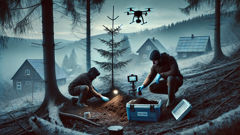
Conclusion
Legends are not fossils; they are living tools. In the Carpathians, the chupacabra is a mirror, reflecting anxieties and curiosities that arise where human life meets rugged, changeable land. The story travels because people need to name the unexpected, and in doing so they convert fear into discussion, suspicion into communal action. Some of the valley's answers were practical: better fences, watch lights, coordinated patrols, and a renewed attention to veterinary care. Others were quieter: a new respect for the seasons, a recognition that what looks like malicious intent could be simply hunger, climate, or displacement. Still, the myth continued to circulate. The young taped the best footage into a montage and the elders told their versions over tea. The scientists returned the following year with more samples, instructing locals how to preserve evidence properly. The teachers incorporated the story into lessons on ecology and careful observation, and children, armed with notepads, became local chroniclers. Over time the name chupacabra, borrowed and reshaped, settled into a local vocabulary without dissolving either the past or the present. It became a shorthand for an array of experiences: unexplained losses, the awkward gap between traditional knowledge and modern science, and the ways communities improvise meaning. The mountain kept holding its own counsel; storms erased tracks, moss grew over disturbed earth, and the pattern of life continued to shift. Yet the conversations it inspired persisted. The legend's power, I think, lies in that persistence: not because the creature must be proven, but because the tale makes people pay attention to the living world around them. In that attentive space, practices change, care deepens, and community resilience increases. This is the most useful outcome of any legend. The Chupacabra of the Carpathians, whether a transient predator, a misread animal, a cultural import, or some combination of the three, has catalyzed a renewed looking at the mountains. That looking is the best defense any place has against loss and the clearest path toward understanding. So the next time fog halves the valley and a shadow moves along the ridge, the people there will be ready: not only to post the clip and wait for strangers to decide, but to step outside with lanterns, to compare notes, to mend the fence. They will tell the story again, altering it subtly, and in that retelling the mountains will be listened to a little more closely than before.

